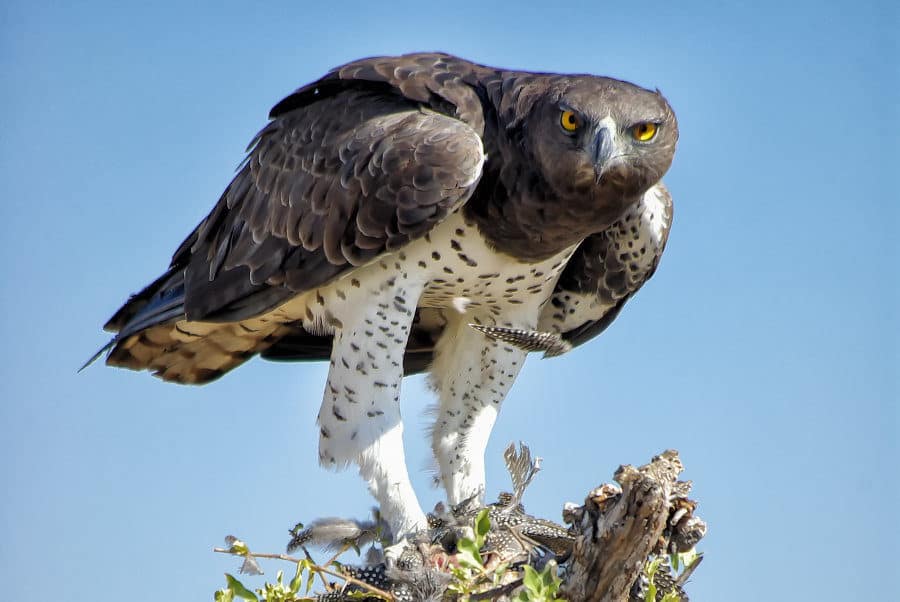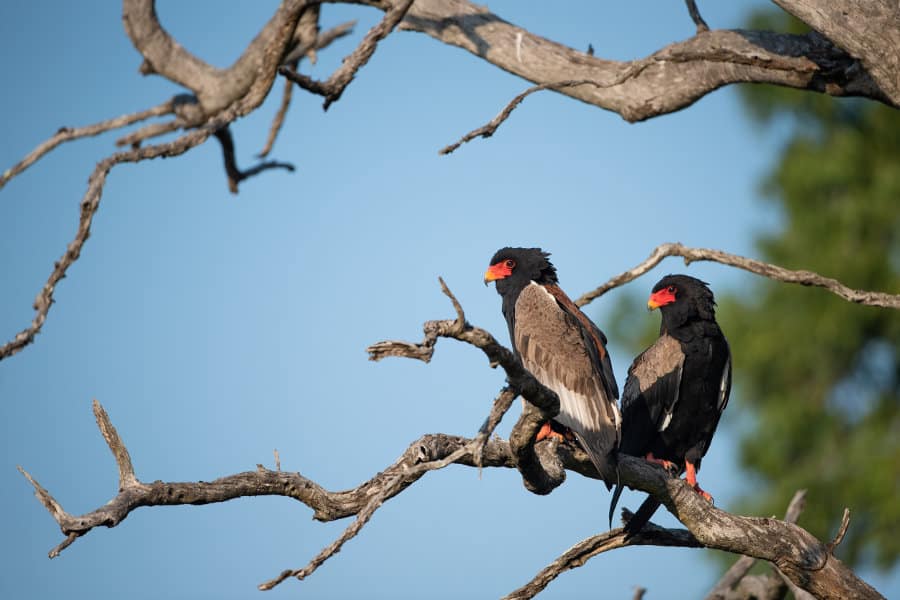Magnificent wings cut across the sky. A martial eagle soars, majestically. No other eagle in Africa is a big.
Lively patterns cover their wings and underbelly. Soaring and soaring the eagle roams the skies, spending endless hours on the thermals.
You can watch their effortless flight for hours. Then every so often a martial eagle descends. Swooping at frightening speed the eagle flies down onto its prey, carrying off venomous snakes, jackals and antelope.
This is one of Africa’s most incredible hunters. Yet they are endangered. They are disappearing from the world.
Here are 14 incredible facts about martial eagles.
1. Martial eagles are classified as vulnerable on the IUCN list
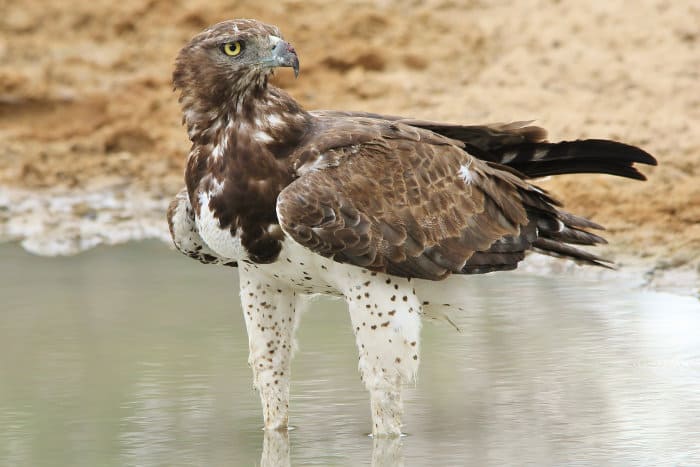
That means they are under threat of extinction. Farmers readily shoot martial eagles as they can swoop down and kill their livestock, especially newborn cows.
Sometimes these birds are shot by game rangers as well! Martial eagles can carry off four-legged mammals and some private game reserves would rather keep their expensive antelope.
2. A martial eagle can break your arm
Don’t mess with these birds. They could break your arm and carry away young children. Their talons will snap a human arm, even if they don’t have the power to carry a person into the air.
Fortunately this is a hypothetical power. Martial eagles are relatively bashful birds and rarely come close to people.
3. They are Africa’s largest eagle with a wingspan of 2.6 metres
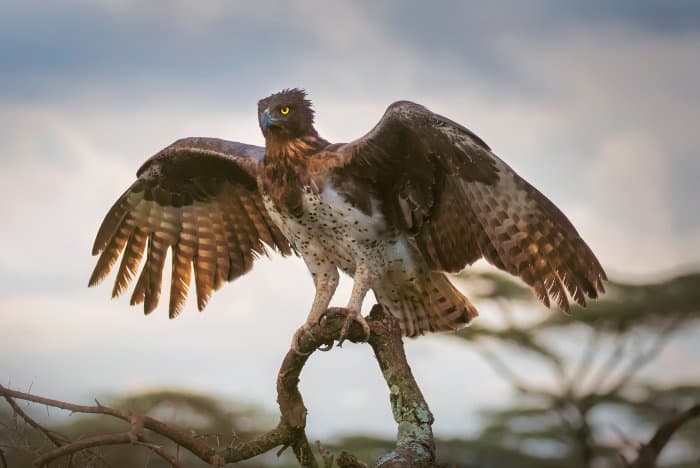
They are also the fifth heaviest eagle on the planet. 🙂
4. These eagles can spot prey from five kilometres away!
Their eyesight is over three times more acute than our own. They soar high above other birds of prey, using this incredible eyesight to spot a potential meal.
5. They hunt silently and secretively
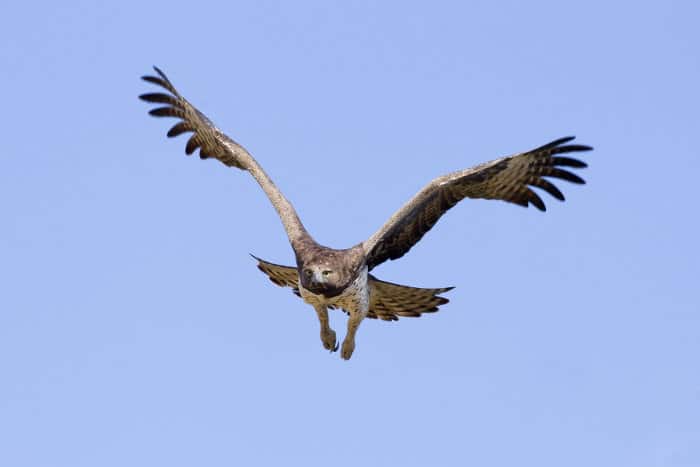
Martial eagles spend most of their day soaring on thermals. After a while they blend into the sky. They don’t even flap their wings, but glide and glide high in the sky.
Animals on the savannah don’t see them as a threat. And then suddenly the eagle pounces.
Speed is their secret weapon. Small quarry will continually check the trees for predators. They don’t expect a killer to descend from so high in the sky.
6. Incredible acceleration when hunting from on high
Most of Africa’s birds of prey swoop from a low height. Many prefer to perch in trees and quickly pounce. Martial eagles can do this as well.
However, they are relatively unique in that they stoop from high in the sky. One tactic they have is to descend at great speeds, angling their approach to land directly on top of their prey.
In open savannah they use a different tactic, first swooping parallel to the ground before chasing and taking prey from behind.
7. They kill using elongated hind toe claws

Their incredibly long and sharp talons are capable of killing small prey instantaneously.
After stooping down they shoot their legs forward, essentially killing the prey on impact. These toe claws also allow the eagle to grab its prey and carry it off to a nest.
8. Birds, mammals and reptiles are all on the menu
They’re not too picky. One study showed that martial eagles in Kruger National Park fed on other birds 45% of the time, especially waterbirds like herons and storks.
Monitor lizards and venomous snakes are favourite meals. Martial eagles will also hunt predatory animals such as jackals.
Young antelope are another popular meal, including klipspringer and impala.
9. Martial eagle pairs have an incredible home range
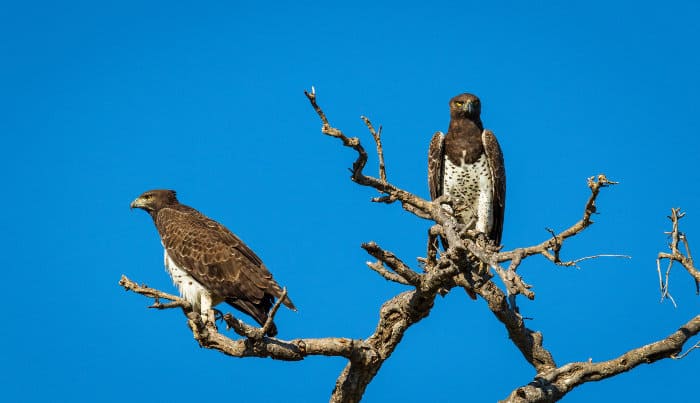
Pairs patrol large territories and will not tolerate the presence of other birds of prey. They typically spend several days hunting in one part of their territory before moving to another.
The size of their territory depends on the food that is available. A range will be 150 square kilometres on average, but it may be more than 1000 square kilometres.
Even during breeding season these birds are usually spotted alone. Males and females will roost in prominent trees that are many kilometres apart.
10. Adult plumage after seven years
These eagles have a striking appearance. White underbellies are speckled with brown spots. A brown head and chest extends into ribboned lines of varying black and brown shades.
Females have more streaks than the males and a martial eagle realises its adult plumage in its seventh year.
11. Martial eagles only lay one egg every two years

Slow reproduction is one of the reasons these birds are endangered. While other eagles will produce offspring every year, martial eagles rarely breed more than once every two years.
There isn’t an obvious pattern. A pair may breed for four consecutive years. Another may be barren for five years.
This erratic pattern makes them a very unproductive bird, and ultimately means that when a martial eagle is poached or hunted, it is hard to replace.
12. Their lifespan is around 12 to 14 years
This is relatively long for birds of prey, although nowhere near as long as other eagles.
Another challenge martial eagles face it that they only reach maturity and start breeding when they are six or seven. So each eagle only has a few years of sporadic breeding.
13. We’re losing these birds from Africa

Martial eagles have what’s called low population replacement. One dies and another doesn’t takes its place.
The IUCN reclassified them as near threatened in 2009. Just four years later they were reclassified as vulnerable. It’s believed that 20% of their population has been lost over the last three generations. 🙁
14. The best places to see martial eagles soaring high
Martial eagles are distributed all across Sub-Saharan Africa. However, they are rarely seen in West Africa and do not live in the Congo Basin.
You may be lucky to spot one in East Africa, on a Kenya safari or Tanzania safari.
The largest populations live in Zimbabwe and South Africa. Kruger is the best place to witness these birds in flight, including the national park and private concessions nearby.
